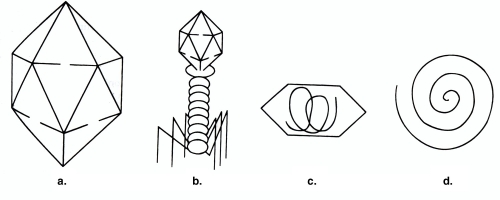A) Lysozyme
B) Reverse transcriptase
C) RNA polymerase
D) DNA- dependent DNA polymerase
E) All of the above
G) D) and E)
Correct Answer

verified
Correct Answer
verified
Multiple Choice
Which of the following is not true about spikes?
A) They may cause hemagglutination.
B) They are only found on enveloped viruses.
C) They are used for penetration.
D) They are used for absorption.
E) None of the above.
G) D) and E)
Correct Answer

verified
C
Correct Answer
verified
Multiple Choice
The following steps occur during biosynthesis of a + strand RNA virus. What is the third step?
A) Synthesis of - strand RNA
B) Synthesis of viral proteins
C) Penetration and uncoating
D) Attachment
E) Synthesis of + strand RNA
G) A) and C)
Correct Answer

verified
Correct Answer
verified
Multiple Choice
The most common route of accidental AIDS transmission to health- care workers is
A) Environmental surface contact.
B) Mouth to mouth.
C) Fecal- oral.
D) Aerosol.
E) Needlestick.
G) None of the above
Correct Answer

verified
Correct Answer
verified
Multiple Choice
The following steps occur during multiplication of Herpesviruses. What is the third step?
A) Biosynthesis
B) Uncoating
C) Release
D) Attachment
E) Penetration
G) A) and C)
Correct Answer

verified
B
Correct Answer
verified
Multiple Choice
The most conclusive evidence that viruses cause cancers is provided by
A) Finding oncogenes in viruses.
B) Treating cancer with antibodies.
C) Some liver cancer patients having had hepatitis.
D) Cancer following injection of cell- free filtrates.
E) The presence of antibodies against viruses in cancer patients.
G) C) and D)
Correct Answer

verified
Correct Answer
verified
Multiple Choice
An infectious protein is a
A) Retrovirus
B) Prion
C) Viroid
D) Bacteriophage
E) None of the above
G) A) and E)
Correct Answer

verified
Correct Answer
verified
Multiple Choice
A viral species is a group of viruses that
A) Have the same genetic information and ecological niche.
B) Have the same morphology and nucleic acid.
C) Infect the same cells and cause the same disease.
D) Can't be defined.
F) All of the above
Correct Answer

verified
Correct Answer
verified
Multiple Choice
Most RNA viruses carry which of the following enzymes?
A) Lysozyme
B) DNA- dependent DNA polymerase
C) ATP synthase
D) Reverse transcriptase
E) RNA- dependent RNA polymerase
G) A) and C)
Correct Answer

verified
Correct Answer
verified
Multiple Choice
Which of the following is most likely a product of an early gene?
A) Capsid proteins
B) Envelope proteins
C) Spike proteins
D) Lysozyme
E) DNA polymerase
G) A) and B)
Correct Answer

verified
Correct Answer
verified
Multiple Choice
Assume you have isolated an unknown virus. It is a single- stranded RNA, enveloped virus. To which group does it most likely belong?
A) Herpesvirus
B) Picornavirus
C) Togavirus
D) Retrovirus
E) None of the above
G) All of the above
Correct Answer

verified
Correct Answer
verified
Multiple Choice
The definition of lysogeny is
A) Lysis of the host cell due to a phage.
B) Phage DNA is incorporated into host cell DNA.
C) When the burst time takes an unusually long time.
D) The period during replication when virions are not present.
E) None of the above.
G) D) and E)
Correct Answer

verified
Correct Answer
verified
Multiple Choice
Which of the following provides the most significant support for the idea that viruses are nonliving chemicals?
A) They cannot reproduce themselves outside of a host.
B) They are filterable.
C) They are chemically simple.
D) They are not composed of cells.
E) They cause diseases similar to those caused by chemicals.
G) B) and C)
Correct Answer

verified
Correct Answer
verified
Multiple Choice
Which of the following is not used as a criterion to classify viruses?
A) Size
B) Number of capsomeres
C) Morphology
D) Nucleic acid
E) Biochemical tests
G) A) and E)
Correct Answer

verified
Correct Answer
verified
Multiple Choice
Bacteriophages and animal viruses do not differ significantly in which one of the following steps?
A) Adsorption
B) Penetration
C) Biosynthesis
D) Release
E) Uncoating
G) A) and C)
Correct Answer

verified
Correct Answer
verified
Multiple Choice
Latent viruses are present in cells as
A) Enzymes.
B) Capsids.
C) Proviruses.
D) Prophages.
E) None of the above.
G) C) and D)
Correct Answer

verified
C
Correct Answer
verified
Multiple Choice
Which of the following is not a method of culturing viruses?
A) In embryonated eggs
B) In laboratory animals
C) In cell culture
D) In culture media
E) None of the above
G) C) and D)
Correct Answer

verified
Correct Answer
verified
Multiple Choice
Generalized transduction differs from specialized transduction in that generalized transduction
A) Transfers specific DNA.
B) Involves lysogeny.
C) Kills the host.
D) Transfers DNA from one cell to another.
E) None of the above.
G) All of the above
Correct Answer

verified
Correct Answer
verified
Multiple Choice
Figure 13.1
 -In Figure 13.1, which of these is a complex virus?
-In Figure 13.1, which of these is a complex virus?
A) a
B) b
C) c
D) d
E) All of the above
G) B) and E)
Correct Answer

verified
Correct Answer
verified
Multiple Choice
DNA made from an RNA template will be incorporated into the virus capsid of
A) Influenzavirus.
B) Retroviridae.
C) Bacteriophage families.
D) Hepadnaviridae.
E) Herpesviridae.
G) B) and E)
Correct Answer

verified
Correct Answer
verified
Showing 1 - 20 of 45
Related Exams